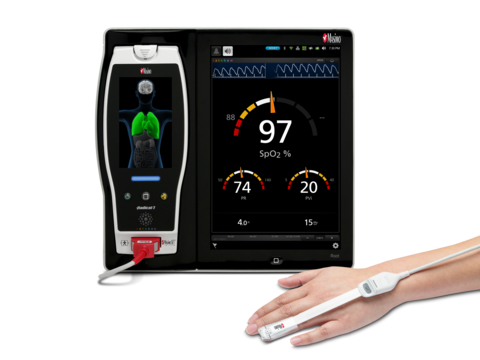NEUCHATEL, Switzerland– Masimo (NASDAQ: MASI) announced today the findings of a study published in the Turkish Journal of Emergency Medicine in which Drs. Seda Dağar and Hüseyin Uzunosmanoğlu at the Kecioren Training and Research Hospital in Ankara, Turkey investigated the role that noninvasive, continuous Masimo PVi® might play in monitoring volume status and volume changes in spontaneously breathing patients undergoing hemodialysis (HD).1 The researchers found that there was a “strong correlation” between change in PVi and the volume of fluid removed, concluding that “PVi may provide clinicians with useful information for monitoring the volume status in critically ill patients with spontaneous breathing.”
More than 100 independent studies have demonstrated the utility of PVi as an indicator of fluid responsiveness.2 Noting that PVi has been studied mostly in mechanically ventilated patients, the researchers sought to investigate its ability to help assess volume changes in spontaneously breathing patients. They enrolled 60 adult patients with end-stage renal disease who received routine HD (during which fluid is removed simultaneously with the removal of waste solutes) and had a median of 3,500 cc of fluid removed during HD. PVi was measured using a Masimo pulse oximetry sensor attached to a Masimo Root® monitor, before and after HD, and changes in PVi were compared to the amount of fluid removed during the session.
The researchers found that mean PVi showed a statistically significant increase after HD, from 20.7% ± 5% to 27.7% ± 6% (p < 0.001). Based on the amount of fluid removed during HD, the change in PVi was statistically significant (p = 0.015) and was strongly correlated to the volume of fluid removed (r = 0.744, p < 0.001).
The researchers concluded, “In the present study, we found that the fluid removed by HD in spontaneously breathing patients caused an increase in PVi and that this increase was strongly correlated with the amount of volume change. Bedside monitoring of PVi, which is a noninvasive, fast, reproducible measurement parameter, may provide the clinicians with useful information for monitoring the volume status and evaluating the effectiveness of volume‑restoration therapy in critically ill patients with spontaneous breathing.”
The accuracy of PVi in predicting fluid responsiveness is variable and influenced by numerous patient, procedure, and device-related factors. PVi measures the variation in the plethysmography amplitude but does not provide measurements of stroke volume or cardiac output. Fluid management decisions should be based on a complete assessment of the patient’s condition and should not be based solely on PVi.
In the U.S., PVi is cleared as a noninvasive, dynamic indicator of fluid responsiveness in select populations of mechanically ventilated adult patients.


